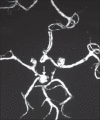An elusive diagnosis: Scedosporium apiospermum infection after near-drowning
- PMID: 21085536
- PMCID: PMC2981763
- DOI: 10.4103/0972-2327.70878
An elusive diagnosis: Scedosporium apiospermum infection after near-drowning
Abstract
A 51-year-old male was admitted in our institute following an episode of near-drowning. He later developed ventriculitis and cerebral ring-enhancing lesions. He died following a subarachnoid hemorrhage due to rupture of a mycotic aneurysm involving the right fetal posterior cerebral artery. Scedosporium apiospermum was isolated from the cerebrospinal fluid. Central nervous system invasion by S apiospermum may present insidiously in near-drowning patients and, therefore, requires a high index of suspicion. In cases with the characteristic cerebral ring-enhancing lesions and concomitant ventriculitis, treatment should be instituted while awaiting fungal culture. With this article we intend to alert neurologists, intensivists, and physicians to this near fatal infection, as early identification and prompt treatment with voriconazole may be life saving.
Keywords: Fungal meningitis; Pseudallescheria boydii; Scedosporium apiospermum; near-drowning.
Conflict of interest statement
Figures



Similar articles
-
Scedosporium apiospermum: An Emerging Fatal Cause of Fungal Abscess and Ventriculitis after Near-drowning.Asian J Neurosurg. 2018 Jul-Sep;13(3):792-796. doi: 10.4103/ajns.AJNS_236_16. Asian J Neurosurg. 2018. PMID: 30283549 Free PMC article.
-
Scedosporium apiospermum infection after near-drowning.Mycoses. 2007 Sep;50(5):412-21. doi: 10.1111/j.1439-0507.2007.01388.x. Mycoses. 2007. PMID: 17714363 Review.
-
A systemic infection involved in lung, brain and spine caused by Scedosporium apiospermum species complex after near-drowning: a case report and literature review.BMC Infect Dis. 2024 Mar 21;24(1):342. doi: 10.1186/s12879-023-08279-9. BMC Infect Dis. 2024. PMID: 38515075 Free PMC article. Review.
-
Infection of the CNS by Scedosporium apiospermum after near drowning. Report of a fatal case and analysis of its confounding factors.J Clin Pathol. 2004 Feb;57(2):205-7. doi: 10.1136/jcp.2003.8680. J Clin Pathol. 2004. PMID: 14747453 Free PMC article.
-
Systemic Scedosporium apiospermum Infection Affecting Multiple Sites After Near-Drowning: A Case Report.Infect Drug Resist. 2024 Dec 20;17:5739-5744. doi: 10.2147/IDR.S483524. eCollection 2024. Infect Drug Resist. 2024. PMID: 39720616 Free PMC article.
Cited by
-
Multi-organ involvement caused by Scedosporium apiospermum infection after near drowning: a case report and literature review.BMC Neurol. 2024 Apr 15;24(1):124. doi: 10.1186/s12883-024-03637-9. BMC Neurol. 2024. PMID: 38616262 Free PMC article. Review.
-
Rapid sequential development and rupture of mycotic aneurysms within a period of days in a patient with graft-versus-host disease and angiotropic Scedosporium apiospermum infection.Surg Neurol Int. 2022 Jun 10;13:242. doi: 10.25259/SNI_970_2021. eCollection 2022. Surg Neurol Int. 2022. PMID: 35855168 Free PMC article.
-
Fatal mycotic aneurysms due to Scedosporium and Pseudallescheria infection.J Clin Microbiol. 2011 May;49(5):2067-71. doi: 10.1128/JCM.02615-10. Epub 2011 Mar 23. J Clin Microbiol. 2011. PMID: 21430108 Free PMC article.
-
A case of scedosporium prolificans osteomyelitis in an immunocompetent child, misdiagnosed as tubercular osteomyelitis.Indian J Dermatol. 2013 Jan;58(1):80-1. doi: 10.4103/0019-5154.105319. Indian J Dermatol. 2013. PMID: 23372223 Free PMC article. No abstract available.
-
Scedosporiosis and lomentosporiosis: modern perspectives on these difficult-to-treat rare mold infections.Clin Microbiol Rev. 2024 Jun 13;37(2):e0000423. doi: 10.1128/cmr.00004-23. Epub 2024 Mar 29. Clin Microbiol Rev. 2024. PMID: 38551323 Free PMC article. Review.
References
-
- Kwon-Chung KJ, Bennet JE. Medical mycology. Philadelphia: Lea and Febiger; 1992. pp. 678–94.
-
- Alexopoulos C, Mims C, Blackwell M. Introductory mycology. New York: Wiley and Sons; 1996.
-
- Koneman EW, Allen SD. Color atlas and textbook of diagnostic microbiology. Philadelphia: JB Lippincott; 1992. pp. 792–6.
-
- Nesky MA, McDougal EC, Peacock JE., Jr Pseudallescheria boydii brain abscess successfully treated with Voriconazole and surgical drainage: case report and literature review of central nervous system pseudallescheriasis. Clin Infect Dis. 2000;31:673–7. - PubMed
-
- Wilichowski E, Christen HJ, Schiffmann H, Schulz-Schaeffer W, Behrens-Baumann W. Fatal Pseudallescheria boydii panencephalitis in a child after near-drowning. Pediatr Infect Dis. 1996;15:365–70. - PubMed

